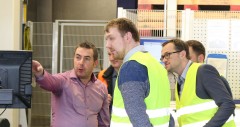HERMA’s self-adhesive materials division commits to Industry 4.0
While everyone seems to be talking about Industry 4.0 – the future of manufacturing, HERMA has already put theory into practice in self-adhesive materials production. At headquarters in Filderstadt in southwest Germany, it is implementing a largely self-organising production regime that intelligently interconnects machines, lines, products and logistics. To this end, it has now completely automated communication within manufacturing in the existing coating pant. The controls of 14 different lines, including coating, slitting and packaging lines, now communicate with each other and the central SAP enterprise software by exchanging around 15,000 datagrams a day. This approach is being adopted from the outset in the new coating plant as well. It is currently under construction at a cost of around 80 million euros and scheduled for commissioning this autumn. The solution being applied by HERMA has already attracted interest from other industrial sectors in which products are likewise coated and shipped on rolls.
Outstanding delivery speed and accuracy
Individual lines and systems are interconnected by special OPC routers. These serve as interpreters; they translate the language of PLC-controlled machines, for example, into data that can be read by SAP. They translate in the other direction as well. “This has enabled us to build event-driven manufacturing processes,” says HERMA managing director Dr. Thomas Baumgärtner. Upon completion of a production stage, for instance, the following line already ‘knows’ what is to be done with a roll of self-adhesive material, ‘autonomously’ selects suitable packaging, and reports the weight to SAP, which in turn produces loading documents for shipping and customs purposes. “In consequence,” reports Dr. Baumgärtner, “we are recording extremely good outcomes as regards delivery speed and accuracy.”
Very high process reliability
As a whole, the system offers extensive functionality. The machines send information concerning wear and maintenance intervals to SAP, for example, which responds by generating a ticket for the competent service engineer as required. “This connectivity finally closes the gaps in the predictive maintenance loop. In particular, however, the data captured throughout production also serve the key purpose of facilitating the seamless tracking and highly detailed reproduction of manufacturing parameters. We are therefore achieving very high process reliability,” explains the managing director. “On top of that, with the aid of these centrally stored data, we can also eliminate defective sections of a roll of material much more quickly. The slitter automatically retrieves the required data from the SAP system. This not only saves a lot of time, because far fewer metres of the roll require winding, but also reduces the number of possible splices, which is a significant plus point for label printers,” comments Dr. Baumgärtner. It was these capabilities in particular that prompted a delegation of specialists from Klingspor to visit HERMA recently for a live demonstration. Incorporated in Haiger in mid-west Germany, Klingspor is a family business steeped in tradition. It ranks among the world’s leading manufacturers of abrasives, and currently employs around 2,500 people. Some of its manufacturing technologies and processes are similar to those that apply in the self-adhesive materials segment. “We were very impressed by what HERMA has already achieved,” remarks Klingspor executive assistant Jonathan Mankel. “We have seen how the idea of Industry 4.0 can be put into practice and generate substantial efficiency gains in a broad-minded, medium-sized business. In the context of our own plans and projects in this field, our discussions with HERMA delivered valuable insights.”






